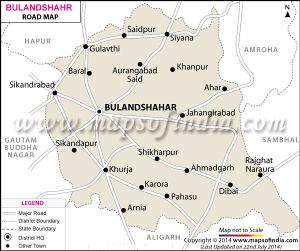Ahar Bulandshahr
Note - Please click → Ahar for details of similarly named villages at other places.
| Author:Laxman Burdak, IFS (Retd.) |

Ahar (आहार) is town in Bulandshahr district in UP.
Location
It is situated on the bank of River Ganga in north-east corner of the district. Its PIN Code is - 202398.
Jat Gotras
History
The coins of Nagavanshi rulers are still found at village Āhār in Bulandshahr district in Uttar Pradesh. These coins depict symbols of Nagas on them. There is mention of Nagas in Mahabharata in a story in which Duryodhana poisoned Bhima to kill and threw into Ganga River. When he was floating in river he reached village Āhār where the Nagavanshi rulers took him out from Ganga River and gave treatment to cure. After treatment he was sent to Hastinapur.
The history of Bulandshahr begins even before 1200 BCE. This region is close to the capital of the Pandavas - Indraprastha and Hastinapur. After the decline of Hastinapur, Ahar, which is situated in the north-east of Bulandshahr District, became an important place for the Pandavas. Later the king Parma made a fort in this part of the region and a king named Ahibaran laid the foundation of a tower called Baran (Bulandshahr). Since it was perched on a highland it came to be known as "high city", which translates as Bulandshahr in Persian language. King Ahivarn or Ahibaran was a Kshatriya and a Suryavanshi (lineage of the Sun). He was the 21st descendant of Samrath (Emperor) Mandhata, the ruler of Ayodhya. As per Mahalakshmi Vrat Katha, it is under Emperor Mandhata lineage that at one stage son of King Vallabh, Agrasen was born and at another stage son of King Parmaal, Ahivarn was born; both of whom further started their own Vansh: Agrawal (or Agarwal) and Varnwal (or Barnwal).
According to Dilip Singh Ahlawat [2], These Naga Jats ruled over Kantipur, Mathura, Padmavati, Kausambi, Nagpur, Champavati, (Bahgalpur) and in the central India, in western Malwa, Nagaur (Jodhpur- Rajasthan). In addition they ruled the ancient land of Shergarh, (Kotah Rajasthan), Madhya Pradesh (Central India), Chutiya, Nagpur, Khairagarh, Chakra Kotiya and Kawardha. The great scholar, Jat Emperor, Raja Bhoja Parmar, mother Shashiprabha was a maiden of a Naga Clan.
The great warrior-saint Tejaji 's (A Jat of the Dhauliya Gotra of Rajasthan) brave wife Bodal, lost her life fighting a Naga youth named Balu. A shrine to the warrior saint Teja is erected there. In Rajasthan today there are many Jats of this Naga clan.
In Uttar Pradesh there are many villages of Naga Jats, some villages are - Rampuria, Khudaganj, Dharampur in the district of Badayun and Ahar in the District of Bulandshahr. Legend has it that Ahar is the same ancient village where, Bhimsen was poisoned by Duryodhana and thrown into the Ganga River. Bhimsen was saved by the Nagas. [3]
Important places in Ahar
In in Ahar - on the bank of river Ganga is situated the famous temple of goddess Avantika & another one temple of Shiva.
Ahar stone Inscription
Ahar stone Inscription of the time of Pratihara Bhijadeva dates ranging from Harsha 258-298 = AD 864-904.[4]
बुलंदशहर
विजयेन्द्र कुमार माथुर[5] ने लेख किया है कि....बुलंदशहर (उत्तर प्रदेश) (AS, p.640) कालिंदी नदी के दक्षिणी तट पर है. अहार के तोमर सरदार परमाल ने इसे बसाया था. पहले यह स्थान बनछटी कहलाता था. कालांतर में नागों के राज्य काल में इसका नाम अहिवरण भी रहा. पीछे इस नगर को ऊंचनगर कहा जाने लगा क्योंकि यह एक ऊंचे टीले पर बसा हुआ था. मुसलमानों के
[पृ.641]: शासनकाल में इसी का पर्याय बुलंदशहर नाम प्रचलित कर दिया गया. यहां [[Alexander|अलेक्षेंद्र के सिक्के मिले थे. 400 से 800 ईस्वी तक बुलंदशहर क्षेत्र में कई बौद्ध बस्तियां थीं. 1018 ईस्वी में महमूद गजनवी ने यहाँ आक्रमण किया था. उस समय यहां का राजा हरदत्त था.
Ahar in Iran
- See Ahar in Iran
References
- ↑ Jat History Dalip Singh Ahlawat/Chapter III (Page 242)
- ↑ Jat History Dalip Singh Ahlawat/Chapter III,p.241
- ↑ http://groups.yahoo.com/group/JatHistory/message/1039.
- ↑ Indian epigraphy: a guide to the study of inscriptions in Sanskrit, Prakrit: By Richard Salomon
- ↑ Aitihasik Sthanavali by Vijayendra Kumar Mathur, p.640-641
Back to Jat Villages

